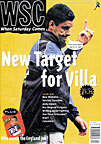 Rather then follow the general consesus of an uphappy team, Argentina's national squad have taken a different approach. Peter Hudson investigates
Rather then follow the general consesus of an uphappy team, Argentina's national squad have taken a different approach. Peter Hudson investigates
Any strike is a rarity in Argentina these days, given the weakness of the local labour movement. But the latest is doubly unusual in being led by professional footballers, hardly noted for their revolutionary fervour. What’s more, the players are not looking for higher wages or better conditions. Rather, they are withdrawing their labour in defence of their poorer colleagues, who have been prevented from plying their trade by a court order late last year suspending all matches outside the First Division.
There is something vaguely incongruous about players like Marcelo Gallardo, River Plate’s brilliant young midfielder, who makes around £1.25 million a year, showing solidarity with players who barely scrape a living scuffing away each weekend in front of a few hundred fans. Can it really be that Argentinian football’s rich and powerful have discovered a social conscience?
Unfortunately, things are not as clear-cut as they appear. Certainly, Argentinian players are notoriously fractious. This is their 12th strike, the most recent of which was in 1997, when they came out in support of four fellow players demanding freedom of contract. Strike action brought professionalism in 1931, freedom of movement and the minimum wage in 1948 and a players’ charter in 1971. And it was the Argentinians, particularly Diego Maradona and Jorge Valdano, who led protests at being forced to play in the midday sun at Mexico 86.
However, there is more to this than meets the eye. For one thing, when the players declared their strike, they were not formally working anyway, since the season had yet to begin. The clubs have also made no move as yet to withhold their wages. Indeed their decision was backed, at least initially, by the club owners and the Argentine Football Association, AFA, organisations with little previous track record of altruism.
To understand how football’s rich and powerful have come to line up in defence of its poor and unfortunate, you have to go back to the incidents that sparked the original court decision to suspend the lower divisions.The ban came in response to a series of near riots organised by the barras bravas, the clubs’ deranged hooligan shock forces. As well as dabbling in drug sales, the barras fund themselves by collecting protection money from their own players.
Since they lead the chants during matches they ensure that any who have not paid up are ruthlessly heckled. More imaginative fund-raising schemes have included breaking down the dressing room door after a match and ripping the shirts off the players’ backs to use as raffle prizes.
The barras’ tactics for dealing with opposing fans shares the same brutal directness. In one infamous battle in 1994, supporters of Boca Juniors fired more than 30 shots at fans from their traditional rivals River, killing two of them and seriously wounding three more. Another two dozen fans have been murdered at football matches this decade.
Such incidents have led to court-imposed stoppages at all levels of football, but especially in the lower divisions where grounds are typically dilapidated and insecure. Nevertheless, the club owners have shown considerable reluctance to grasp the nettle. Taking its lead from its members, the AFA has also taken scant notice of the demands of the judges to impose fines and deduct points for crowd violence.
The reluctance to act comes partly from fear. But it is also because the barras bravas can be very useful. Within the clubs, directors have enlisted them to impose order, giving a hard time to players who are refusing to sign a new contract, for instance. In addition, many of the lower division clubs are the fiefdoms of political leaders who use the barras for packing rallies and settling scores with their opponents. “Some clubs only have football as an excuse for their other activities,” says Ezequiel Fernandez Moore, a local sports writer.
The clubs and the AFA, like the players, reckoned that the judges, confronted by public outrage at the potential cancellation of the season, would quickly call off any bans and allow them to go on ignoring the root of the problem. The judges, however, have shown no sign of letting their arms be twisted. With the season now one week old and no prospect of any matches being played, the AFA and the clubs are becoming increasingly anxious about a fixture pile-up and a resulting loss of revenues which few clubs are solvent enough to bear indefinitely.
A fairer share-out of the £30 million in TV revenues, so that some reached the lower divisions, would help. But in order for that to happen the First Division clubs would have to accept a reduction in their take, which might even mean a cut in players’ salaries. As the prospect of a quick and easy solution recedes, that logic is already weakening support for the strike. In the end the players look likely to heed the advice of President Carlos Menem, who reportedly told their leaders during a private meeting, “solidarity is all well and good, but there are limits”.
From WSC 146 April 1999. What was happening this month